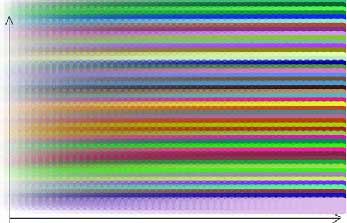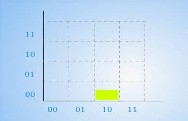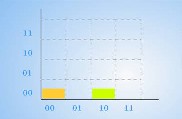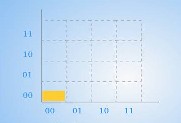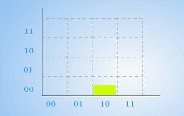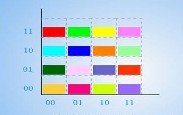Example ¹1
Example ¹2

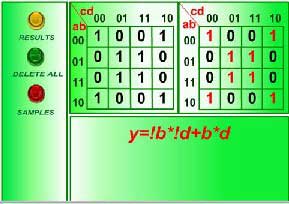
SCIENTIFIC ADVISER: Anoprienko A. Y.
1. 1. Illustrative and cognitive functions of computer graphics and cognitive computer simulation
Nowadays computer graphics (CG) is one of the most highly developed directions of information technologies. In modern scientific researches including fundamental investigations computer graphics becomes a complex cognitive tool – popular attribute of modern educational process and scientific investigations.
The main functions of computer graphics are illustrative and cognitive functions. Illustrative function of CG reduces to realization something that is known or something that exists in world around us or in researcher’s head in any visual image. Cognitive function role is to get knowledge using any image that still does not present even in researcher’s head to promote to intellectual process of getting this knowledge.
Today together with traditional computer simulation CG becomes the part of advanced development of information technologies – cognitive computer simulation (CCS).
CCS is based just on the mental faculties of human intellect to thinking that consists of six main operations: analysis, comparison, generalization, synthesis, abstracting, concrete definition.
As a result of those 6 operation in human’s consciousness on basis of sensory data (visual, ear, tactile sensation and so on) appear definite theoretic and practice resumes. This gives us new estimates and ways of improvement for the object of perception.
As thinking is directed on getting qualitative theoretic knowledges and its practice use perception and memorization don’t have sense without it. Exactly because of this the major aim becomes not just beautiful, visual and more informative simulation of different processes but help in intelligent perception of integral image making it nonstatic constantly changed, help in finding new features, tints. All this assists in searching the most rational decisions for new problems.
First task is creating such models of knowledge’s representative in which opportunity to represent with monotonous tools objects which are characteristic for logic thought, fancies-pictures which are typical for creative thinking, could be.
Second task is visualization of those human knowledges, for which it is not possible to select text descriptions.
Third task is searching the ways to move beyond fancies-pictures which are under review to formulating some hypothesis about those mechanisms and process, which are hided by dynamic of pictures which are under review.
Those three tasks of CCS have to be completed by forth task. It lies in creating conditions for development professionally oriented intuition and creative abilities by construction interface that is based on methods of cognitive graphics.
Modern information technologies are almost completely based on binary logic. But in the conditions of network parallelism are showed defects of traditional Boolean logic. On this stage they are compensated due to algorithmic program apparatus. But in spite of reaching the universality of modern computer systems in such way it leads to lowering the
characteristics on some orders in compare with hardware support of similar functions. 1111 111M = {1111 1110; 1111 1111}
In context of this work cognitive simulation is a tool for visualization the conception of hypercodes, as about evolutionally new form of representative the code-logical basis. This conception is probably abstract idea at this point of its development.
Binary code is a special case of multivalued logic. One of the traditional forms of its representative is “Karnaugh map”.
One way of improvement traditional binary logic lies in move to multivalued logic.
Realization of hardware devices which are built on multivalued logic becomes interesting for the International Technology Roadmap for Semiconductors (ITRC).
Now it could be possible. Companies, that produce semiconductors are very interested in new exotic combinations, such as silicon germanium (SiGe) as ways in which wireless devices can be pushed to clock rates approaching 100 GHz.
Transistors built with SiGe are capable of producing multiple threshold levels. It means compatibility with multivalued logic. According to expert’s calculations 16-bit microcomputer built on binary logic has access to no more than 216 bits memory (about 65k bits), while that same microcomputer with memory based on ternary logic would have direct access to 316 or 43 Mbits of memory.
Quaternary logic like the ternary logic is a part of multivalued logic. Besides classic 1 (TRUE) and 0 (FALSE) it includes different pairs of combinations with next definitions:
- M as “ plurality”;
- À as “posibility”, “ equiprobability”;
- and some others.
On the base of quaternary logic conception of quaternary code is used. It represents widening of usual binary code. Each order of quaternary code represents combinations that consist of 2 bits. For each combination there is one from four states of quaternary logic. In such way amount of bits for the representatives of the number increases in two times, but for all that quality important modification of the code comes true: from the pointwise number it turns into one-dimensional number that is effectively used
all space of number axis.
Presence just in one order value M will lead to the plurality of the value. Like this:
Quaternary codes are highly effective objects, which allow to overstep the limits of traditional computer binary logic. They give opportunity to approach computer logic to the logic resides to the human being.
3. VIZUALIZATION HYPERCODES USING COGNITIVE SIMULATION
3.1. Topicality of conception of multivalued logic
There are definite conditions for the future development of this conception.
Multivalued logic today is included in spectrum of those problems, which have to be solved. The development of this direction may severely increase capabilities of computer technique, to open new horizons for creating artificial intelligence, to work as a base for improvement molecular biology, genetics, chemistry, physics, mathematics and many others fundamental sciences.
3.2. Visualization of «Karnaugh map» as a special case of representative hypercodes
If consider “Karnaugh map” in context of multivalued space, it is possible to define such major values, which usually use, working with “Karnaugh map”:
1 - TRUE;
0 – FALSE;
* - indifference to value TRUE or FALSE.
"*" may be considered as other, additional, logical value.
In the context of this work it was developed interface for working with “Karnaugh map”. It was realized algorithm of “gluing together” “Karnaugh map” with dimension 4*4 for 4 values in binary code.
Example of working this program is on the Figure 3.1.
|
Example ¹1 |
Example ¹2 |
|
|
|
Figure 3.1 - Realization of algorythm "Karno map"
Rank of hypernumbers with coordinates 50\50 Rank of hypernumbers with coordinates 20\20 Figure 3.2 - First method of vizualization of hypercodes Input data Output data Input data Output data 0010 00Ì0 00À0 00À0 ÌÌÌÌ Figure 3.3 - Second method of vizualization of hypercodes3.3. Model of hyper code’s visualization
For the solving of any scientific problem it is necessary to imagine the ways of its solutions. From the multitude of the decisions to chose the right one. In the case with hypercodes you have to think over all variants of their visualization and to chose the most understandable and informational one.
So the next part of this work was searching the methods of visualization hypercodes on the number axis õ, ó. Program was designed. The input data of it ase 2 numbers (2 coordinates). If a question was in usual numbers, the result of work could be usual point on coordinate space.
The case with hypercodes is more difficult. Here the result has to be a range of hyper numbers. As hyper number could be defined as a range too, so the result ought to be the range of the ranges, where each hypernumber can cross with other. At the same time all ranges have to be different.
Work in this direction is still underway on, but previous result is showed on the figures 3.2 and 3.3 texture.
As you can see on the figures 3.2 and 3.3 hypernumbers can be in different ratio with each other in the dependence of coordinates.
